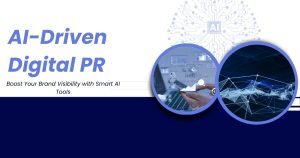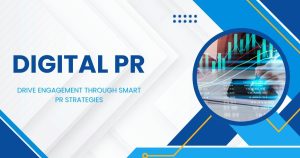What is Digital PR in SEO? Guide for Marketers
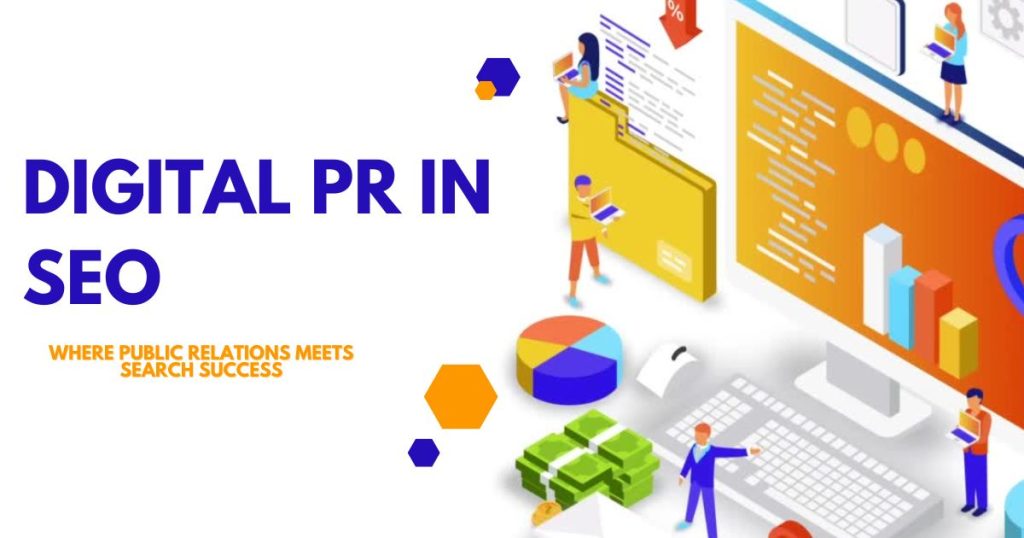
Digital PR has evolved far beyond traditional press releases and media outreach. For modern marketers, it represents one of the most powerful ways to build brand authority, earn high-quality backlinks, and boost search engine rankings. But what exactly is digital PR in the context of SEO, and how can you leverage it to grow your online presence?
Digital PR marketing combines traditional public relations tactics with digital marketing strategies to increase brand visibility across online channels. Unlike conventional PR, which focuses primarily on securing coverage in newspapers and magazines, digital PR targets online publications, blogs, podcasts, and social media platforms to build brand awareness and drive organic traffic.
The connection between digital PR and SEO runs deeper than many realize. Every piece of coverage, every mention, and every backlink earned through digital PR efforts contributes to your website’s search engine optimization. This symbiotic relationship makes digital PR an essential component of any comprehensive SEO strategy.
How Digital PR Differs from Traditional PR
Traditional PR relies heavily on building relationships with journalists at established media outlets. The primary goals involve securing coverage in newspapers, magazines, television, and radio to reach mass audiences. Success is often measured by circulation numbers, viewership, and general brand awareness metrics.
Digital PR marketing takes a more targeted approach. It focuses on online publications, industry blogs, influencer partnerships, and digital-first media outlets. The emphasis shifts from broad awareness to strategic link building, targeted audience engagement, and measurable SEO benefits.
The measurable nature of digital PR sets it apart from its traditional counterpart. While traditional PR success can be difficult to quantify, digital PR provides clear metrics: website traffic increases, keyword ranking improvements, backlink acquisition, and conversion rates. This data-driven approach allows marketers to prove ROI and continuously optimize their strategies.
The SEO Benefits of Digital PR
Digital PR delivers several key SEO advantages that can significantly impact your search rankings and online visibility.
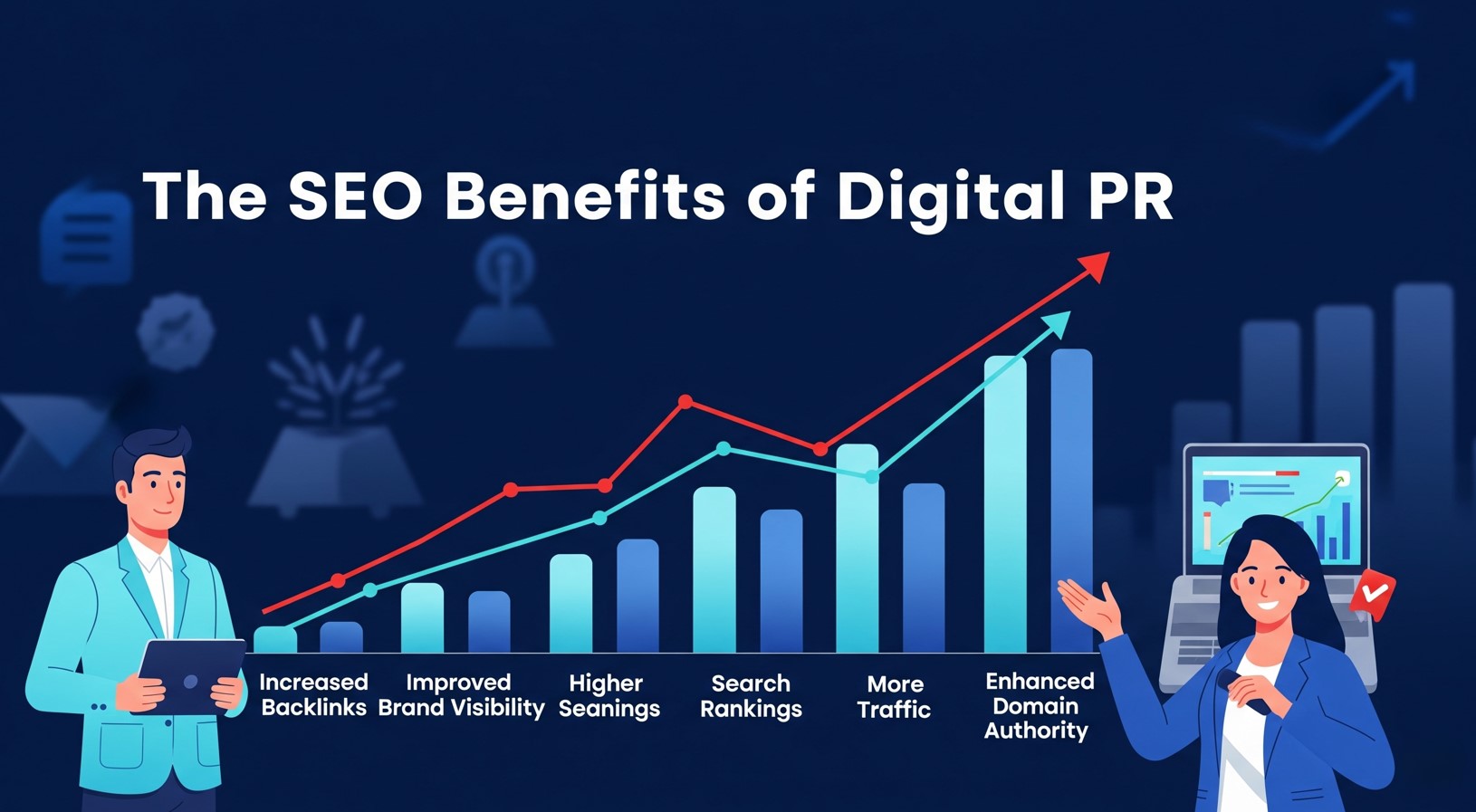
High-Quality Backlink Acquisition
Search engines view backlinks from authoritative websites as votes of confidence. Digital PR helps you earn these valuable links naturally by creating newsworthy content that publications want to reference and link to. Unlike paid link schemes or low-quality directory submissions, digital PR backlinks come from relevant, high-authority sources that search engines trust.
Brand Authority and E-A-T Signals
Google’s E-A-T (Expertise, Authoritiveness, Trustworthiness) guidelines emphasize the importance of demonstrating credibility online. Digital PR coverage in reputable publications signals to search engines that your brand is trustworthy and authoritative in your industry. This social proof can improve your rankings across all search queries related to your business.
Content Amplification
Digital PR helps distribute your content to wider audiences through earned media coverage. When industry publications share your research, insights, or company news, they’re essentially amplifying your content’s reach without additional advertising spend. This increased exposure drives more organic traffic and social signals, both of which can positively impact your SEO performance.
Brand Mentions and Citations
Not all digital PR coverage includes backlinks, but unlinked brand mentions still provide SEO value. Search engines use brand mentions as ranking signals, and consistent citations across authoritative websites help establish your brand’s credibility and relevance in your industry.
Key Digital PR Marketing Strategies
Successful digital PR campaigns require strategic planning and execution. Here are the most effective approaches for earning coverage and building SEO value.
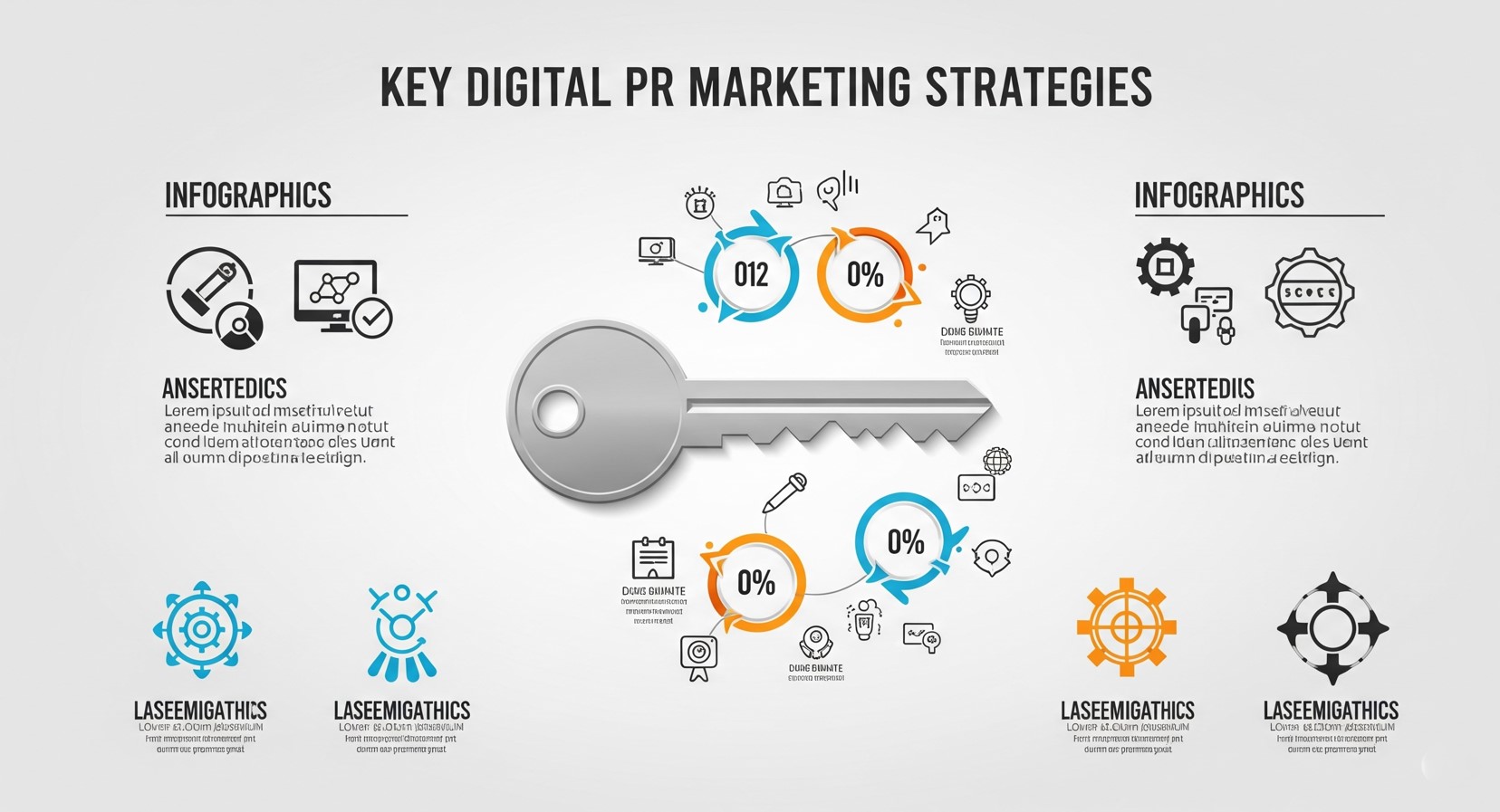
Data-Driven Content Creation
Original research and data analysis provide journalists with valuable content they can’t find elsewhere. Survey your customers, analyze industry trends, or compile interesting statistics that tell a compelling story. Publications are always looking for fresh data to support their articles, making this approach highly effective for earning coverage.
Create visual representations of your data through infographics, charts, and interactive tools. Visual content gets shared more frequently and often earns more backlinks than text-only releases.
Expert Commentary and Thought Leadership
Position your team members as industry experts by offering commentary on current events, trends, and developments in your field. Respond quickly to breaking news with informed perspectives, and proactively share insights on emerging topics.
Build relationships with journalists who regularly cover your industry. Follow them on social media, engage with their content, and offer yourself as a reliable source for future stories. These relationships often lead to recurring coverage opportunities.
Newsjacking and Trend Monitoring
Monitor industry news and trending topics to identify opportunities for relevant commentary. When major events occur in your sector, prepare thoughtful responses that add value to the conversation rather than simply promoting your brand.
Use tools like Google Trends, social media listening platforms, and news aggregators to stay informed about developing stories. Speed matters in newsjacking—being among the first to offer expert commentary increases your chances of earning coverage.
Creative Campaigns and Stunts
Develop creative campaigns that naturally attract media attention. These might include interesting studies, charitable initiatives, or unique product launches that provide journalists with engaging story angles.
Successful creative campaigns solve problems, entertain audiences, or reveal surprising insights. They should feel authentic to your brand while providing genuine value to your target audience.
Measuring Digital PR Success
Tracking the right metrics helps you understand your digital PR performance and optimize future campaigns.
Coverage Quality and Reach
Monitor the authority and relevance of publications covering your brand. Tools like Ahrefs, Moz, or SEMrush can help you assess the domain authority of sites linking to you. Focus on earning coverage from high-authority sites in your industry rather than pursuing quantity alone.
Track the estimated reach of your coverage by noting each publication’s audience size and engagement rates. This data helps you understand which types of stories resonate with different media outlets.
Backlink Acquisition
Use SEO tools to monitor new backlinks earned through your digital PR efforts. Track both the quantity and quality of these links, noting their anchor text, context, and the authority of linking domains.
Set up Google Alerts and use backlink monitoring tools to catch coverage you might otherwise miss. Some publications may cover your story without notifying you directly.
Traffic and Conversion Impact
Analyze your website traffic during and after digital PR campaigns. Look for spikes in organic traffic, direct visits from referral sources, and improvements in keyword rankings for terms related to your coverage.
Track conversion metrics to understand how digital PR traffic converts compared to other sources. This data helps justify your digital PR investment and guides future campaign planning.
Brand Mention Tracking
Monitor both linked and unlinked brand mentions across the web. Tools like Mention, Brand24, or Google Alerts can help you track when your brand is discussed online, even without backlinks.
Unlinked mentions present opportunities for link building outreach. Reach out to publishers who mentioned your brand without linking and politely request they add a relevant link to your website.
Common Digital PR Marketing Mistakes to Avoid
Understanding potential pitfalls helps you execute more effective digital PR campaigns.
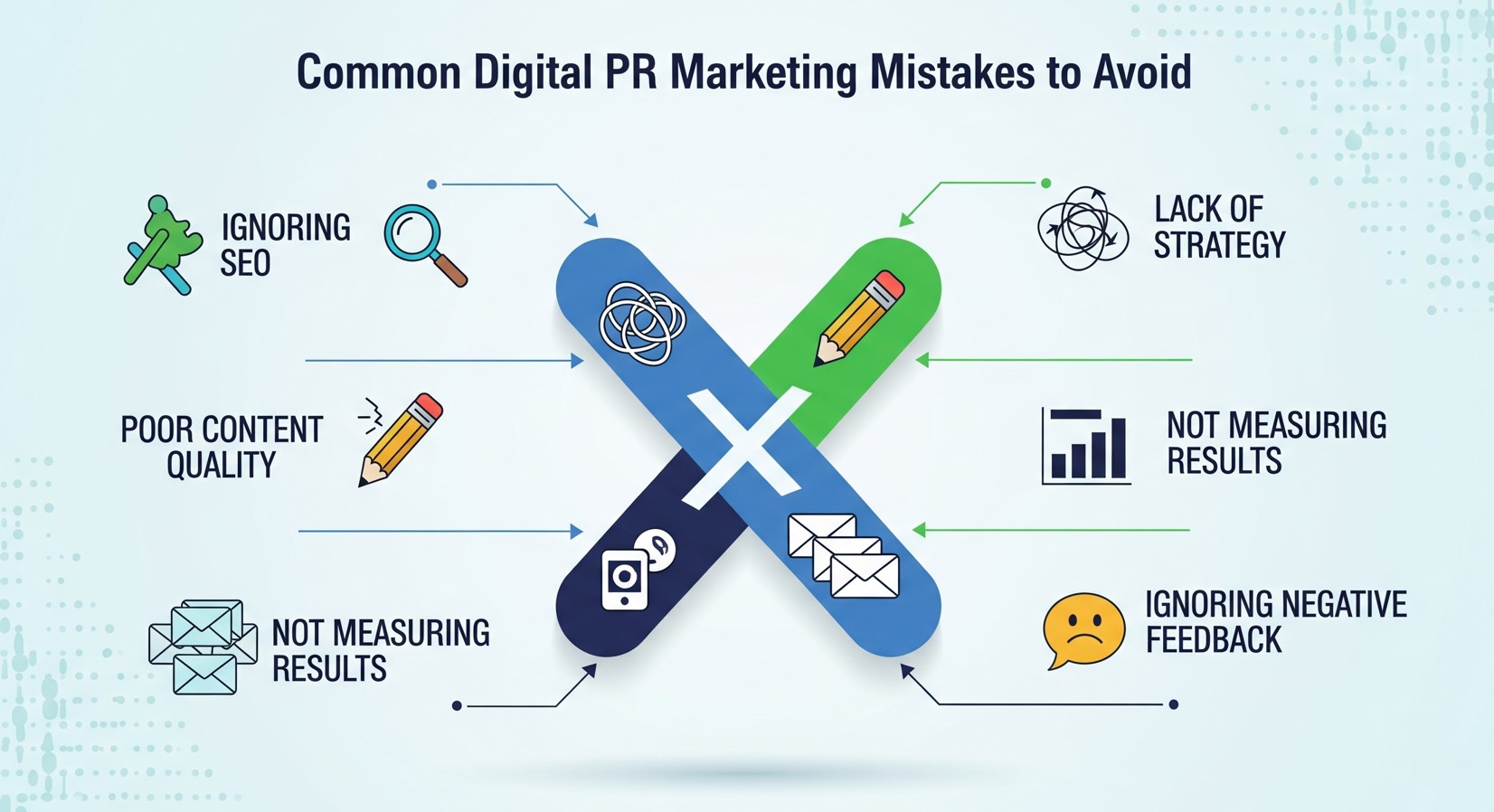
Over-Promotional Content
Journalists and their audiences can quickly spot overly promotional content. Focus on providing genuine value rather than pushing product features or sales messages. Your expertise and insights should be the stars of your pitches, not your products.
Ignoring Relevance
Pitching irrelevant stories to journalists wastes their time and damages your reputation. Research each publication’s content style, audience, and recent coverage before reaching out. Personalized, relevant pitches perform significantly better than mass distribution approaches.
Neglecting Follow-Up
Building media relationships requires consistent communication. Follow up appropriately on pitches, share relevant industry insights regularly, and maintain contact even when you don’t have immediate story ideas.
Focusing Only on Tier-1 Publications
While coverage in major publications is valuable, don’t overlook industry-specific blogs, local media, and niche publications. These outlets often provide more targeted audiences and may be more willing to cover your stories in depth.
Building Your Digital PR Marketing Strategy
Successfully integrating digital PR into your SEO strategy requires careful planning and consistent execution.
Start by identifying your target publications and journalists. Research outlets that regularly cover your industry and note which reporters write about topics related to your expertise. Build a media list with contact information, content preferences, and recent articles from each journalist.
Develop a content calendar that aligns with industry events, seasonal trends, and your business objectives. Plan campaigns around product launches, industry conferences, and relevant awareness months or holidays.
Create systems for monitoring opportunities and measuring results. Set up Google Alerts for industry keywords, competitor mentions, and relevant trending topics. Use SEO tools to track your backlink profile and keyword rankings over time.
The Future of Digital PR and SEO
Digital PR marketing continues to evolve alongside changes in media consumption habits and search engine algorithms. Social media platforms increasingly influence traditional media coverage, while podcasts and video content create new opportunities for brand exposure.
Artificial intelligence and automation are changing how journalists research and write stories, creating both challenges and opportunities for digital PR professionals. Brands that provide easily accessible, well-organized information and maintain strong relationships with media professionals will continue to earn valuable coverage.
The integration between digital PR and SEO will only deepen as search engines become more sophisticated in evaluating brand authority and trustworthiness. Companies that invest in comprehensive digital PR strategies today will build competitive advantages that compound over time.
Digital PR represents one of the most effective ways to improve your SEO performance while building genuine brand authority. By creating valuable content, nurturing media relationships, and consistently monitoring opportunities, you can earn high-quality backlinks that drive both traffic and rankings improvements for years to come.

